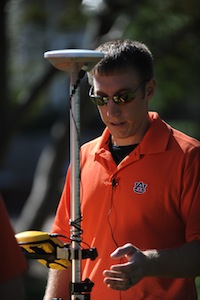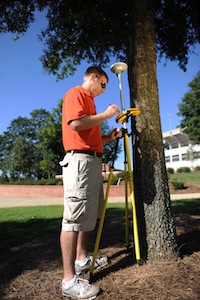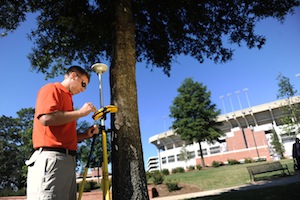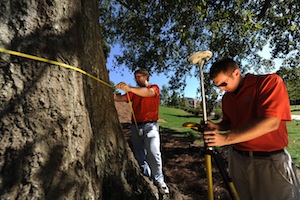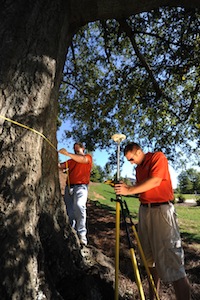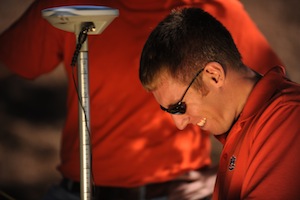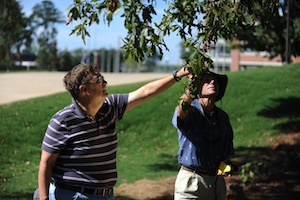Auburn Family Can Take Solace in Campus Trees
In the wake of the poisoning of Auburn University's beloved, more-than-a-century-old, tradition-rich oak trees at Toomer's Corner, Forestry graduate student Nicholas Martin believes the Auburn Family can take solace from the fact that it is the campus-wide collection of trees, and particularly those in the Donald E. Davis Arboretum, that will leave the most significant and lasting impact on current and future generations of Auburn students and the community.
For his master's thesis project, Martin undertook the task of creating an inventory of trees on Auburn's campus as part of a USDA Forest Service grant. Working under the direction of Forestry Professors Art Chappelka and Edward Loewenstein, and Horticulture Professor Gary Keever, Martin utilized the i-Tree Eco protocol developed by the USDA Forest Service, which calls for an incorporation of data including tree species, size, health and location. The data is then used to calculate the environmental benefit provided by each tree, including total carbon storage and sequestration. Results show that with a total of 8,236 trees located on Auburn's campus, close to 4 million pounds of carbon are stored and 173,424 pounds per year are sequestered from the environment.
Martin notes that out of all the trees on campus, 891 are located in the Donald E. Davis Arboretum.
"Trees provide cleaner water, cooler temperatures and shade, and clean air. The benefits that humans gain from trees are huge and the Arboretum provides great benefit to the Auburn campus," says Martin.
According to Martin's calculations, the trees in the Arboretum alone provide 508,513 pounds of carbon storage and 21,302 pounds of carbon sequestration per year. Compared with the rest of campus, the Arboretum sequesters six times the amount of carbon per hectare. The Arboretum's trees are also responsible for an average of 16 percent of the total pollution removal on Auburn's campus, including carbon monoxide, ozone, nitrogen dioxide, and sulfur dioxide.
Included in the collection of trees at the Arboretum is a post oak called the Founder's Oak. The Founders Oak measures 88 feet tall, 47.3 inches in diameter, and 89 feet across the crown width. At more than 150 years old, i-Tree Eco placed a monetary value of $7,700 on the Founder's Oak.
"Emotionally, you can't put a price on a tree that was here before you and could last long after you have passed away," says Martin. "There is a great historical aspect to a tree that has been there for several hundred years. They are living legacies and living history."
The total tree worth of the Arboretum is estimated at $2 million, and the estimated replacement value of every tree on campus is close to $12 million.
"The monetary value of the trees is important because the campus, and particularly the Arboretum, is impacted a lot by outside services like utilities. Now that we can calculate the value of each tree, perhaps they might think twice before cutting another one down," says Keever.
Additionally, the pollutant storage and filtration provided by the trees on campus contribute to the goals of the American Colleges and Universities Presidents Climate Commitment, which was signed by Auburn University President Jay Gogue in 2008. The commitment calls on colleges across the country to strive for a carbon neutral campus.
Auburn was also recognized by The Princeton Review as one of the country's most environmentally responsible universities with inclusion in, "The Princeton Review's Guide to 286 Green Colleges." Designation as a Green College was, in part, due to Auburn's campus and forestry management, and environmental stewardship.
The Arbor Day Foundation, in conjunction with Toyota Motor North America, Inc., also recognized Auburn's dedication to campus tree management by designating the University as a Tree Campus USA 2010. Auburn also received the award in 2009, and was the first college or university in the state to receive the designation. The Tree Campus USA program awards institutions who demonstrate leadership both on campus and in the surrounding communities in areas of promoting environmental stewardship.
Beyond the national recognition and environmental benefits provided by the trees on campus and, in particular, the Arboretum, is an educational element that stretches across colleges and disciplines.
"So many people use the Arboretum throughout the year as an educational component including the colleges of Agriculture, Architecture, Forestry, and Sciences and Mathematics, the offices of Outreach and Sustainability, and the people living in the city of Auburn," says Keever. "Trees, I think, are an overlooked and undervalued asset. People tend to take them for granted but hopefully, with the (Auburn) president's promise to strive for a zero carbon footprint, that will change."
Latest Headlines
-
04/18/2024
-
04/18/2024
-
04/18/2024
-
04/17/2024
-
04/12/2024

